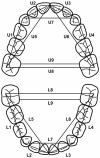Effects of headgear timing on dental arch changes from 7 to 18 years of age: a follow-up study
- PMID: 37607275
- PMCID: PMC10505689
- DOI: 10.1093/ejo/cjad045
Effects of headgear timing on dental arch changes from 7 to 18 years of age: a follow-up study
Abstract
Background: Dental arch effects after cervical headgear (CHG) treatment have been researched from several different perspectives. However, the long-term effects of CHG timing are still unknown.
Objectives: To analyse the long-term effects of CHG timing on dental arches.
Material and methods: A total of 67 children with Angle Class II malocclusion comprised the study group in this trial. The participants were randomized into two equal-sized groups. In the early group (EG, n = 33), treatment was started after the eruption of the first upper molars. In the later-timed group (LG, n = 34), treatment was started 18 months later compared with the early group. Long-term effects were measured from dental casts taken at five time points between 7 and 18 years of age.
Results: The total maxillary dental arch length was achieved earlier, the gained length persisted better in the long term, and significantly more space was achieved in EG compared with LG (P = .048). The intermolar width in the maxillary dental arch was more stable and was reached earlier in EG compared with LG (P = .002). The results showed that in terms of total mandibular arch length increases, EG males benefited the most and LG females the least from CHG treatment (P = .031).
Conclusions: Both genders benefited from earlier CHG treatment. The maxillary dental arches remained longer, and the final width was gained earlier in EG compared with LG.
Keywords: Headgear; dental arch; long-term; timing.
© The Author(s) 2023. Published by Oxford University Press on behalf of the European Orthodontic Society.
Conflict of interest statement
The authors declare that there is no conflict of interest.
Figures




Similar articles
-
Dental arch effects after early and later timed cervical headgear treatment-a randomized controlled trial.Eur J Orthod. 2019 Nov 15;41(6):622-630. doi: 10.1093/ejo/cjy083. Eur J Orthod. 2019. PMID: 30601990 Clinical Trial.
-
Effect of cervical headgear on dental arch area, shape and interarch dimensions : A randomized study.J Orofac Orthop. 2021 May;82(3):153-162. doi: 10.1007/s00056-020-00264-0. Epub 2020 Dec 3. J Orofac Orthop. 2021. PMID: 33270142 Free PMC article. Clinical Trial.
-
Effects of force magnitude on dental arches in cervical headgear therapy.Eur J Orthod. 2022 Mar 30;44(2):146-154. doi: 10.1093/ejo/cjab051. Eur J Orthod. 2022. PMID: 34369566 Free PMC article. Clinical Trial.
-
The extraction of permanent second molars and its effect on the dentofacial complex of patients treated with the Tip-Edge appliance.Eur J Orthod. 2002 Oct;24(5):501-18. doi: 10.1093/ejo/24.5.501. Eur J Orthod. 2002. PMID: 12407946 Review.
-
Short- and long-term dental arch spatial changes following premature loss of primary molars: A systematic review.J Indian Soc Pedod Prev Dent. 2022 Jul-Sep;40(3):239-245. doi: 10.4103/jisppd.jisppd_230_22. J Indian Soc Pedod Prev Dent. 2022. PMID: 36260463
Cited by
-
Effects of early and later timed cervical headgear treatment on the eruption timing and pattern of permanent upper canines and molars from 7 to 18 years of age: follow-up of a randomized controlled trial.Eur J Orthod. 2025 Jun 12;47(4):cjaf056. doi: 10.1093/ejo/cjaf056. Eur J Orthod. 2025. PMID: 40576200 Free PMC article. Clinical Trial.

